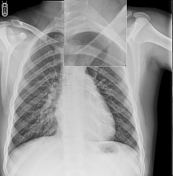Presentation
Fell down from a loft ladder, hit anterior chest on banister with loss of consciousness for 30 seconds. Presented with acute pleuritic chest pain and difficulty in breathing.
Patient Data




Subtle lung edge at the left apex, without cardiomediastinal shift, suspicious for a small simple apical pneumothorax. No rib fractures or other acute traumatic sequelae evident.

Resolution of the small left apical pneumothorax seen two weeks earlier. No other findings of note.
Case Discussion
Subtle pneumothoraces are easy to miss, which is why many radiologists routinely look for a pneumothorax in every chest radiograph that they review. In this case, the diagnosis was made by a non-radiologist in the ED.
Despite the alarming sounding history, vital signs remained unremarkable and the ED physicians had no clinical concerns. Thus it was decided to not perform any further imaging or active intervention. The patient was discharged home the same day.
A follow-up chest radiograph two weeks later showed complete resolution of the pneumothorax.




 Unable to process the form. Check for errors and try again.
Unable to process the form. Check for errors and try again.